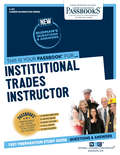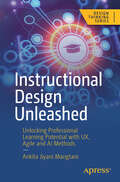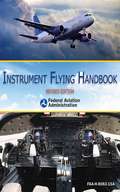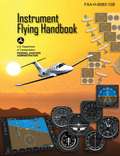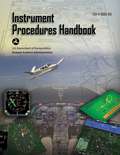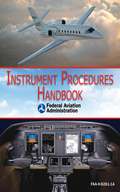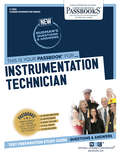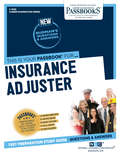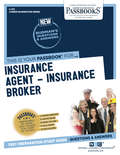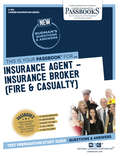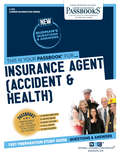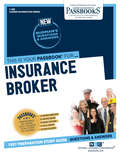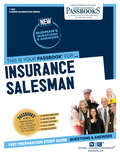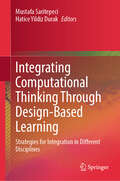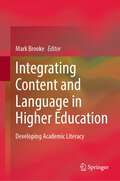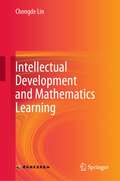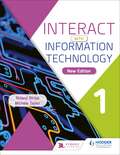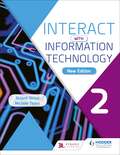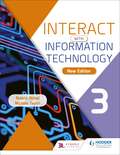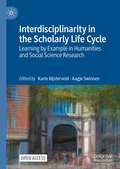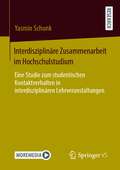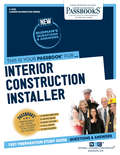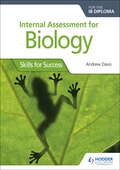- Table View
- List View
Institutional Trades Instructor: Passbooks Study Guide (Career Examination Series)
by National Learning CorporationThe Institutional Trades Instructor Passbook® prepares you for your test by allowing you to take practice exams in the subjects you need to study. It provides hundreds of questions and answers in the areas that will likely be covered on your upcoming exam.
Instructional Design Unleashed: Unlocking Professional Learning Potential with UX, Agile and AI Methods (Design Thinking)
by Ankita Jiyani MangtaniDive into the expansive realm of instructional design and explore a rich tapestry of effective strategies and practical techniques. This comprehensive guide is a treasure trove of insights bridging the theoretical foundations of instructional design with hands-on, actionable methods to elevate learning experiences. After reviewing the fundamentals, you’ll unravel the essence of instructional design, what it entails, and how its principles can be harnessed. Your journey then delves into the scientific underpinnings of learning in professional settings, dissecting pivotal concepts such as cognitive load, cognitive load theory (CLT), learning styles, and modalities. The guide extends its reach to address inclusivity, promoting equitable practices, and mitigating unconscious bias during the design of learning courses and environments. With a solid foundation in place, you’ll examine key frameworks specific to learning and instructional design, including the tried-and-true methodologies of ADDIE, SAM, and ARCS. Going beyond the conventional, the guide widens its lens to incorporate broader methodologies, such as user-experience (UX), Agile methodologies, storyboarding, and gamification, all prevalent in the tech industry. It also delves into virtual learning environments and the nuances of creating effective online learning experiences and contemplates the revolutionary impact of generative AI on reshaping this space. With a forward-looking perspective, Instructional Design Unleashed anticipates and navigates the potential changes and innovations that AI can introduce, positioning instructional designers at the forefront of the evolving landscape of educational technology. What You’ll Learn Uncover the scientific foundations of learning and their seamless integration into the learning experience. Explore practical methodologies and techniques that can be readily applied to enhance your learning projects. Study the vast potential of generative AI within the realms of e-learning and virtual learning environments. Unlock the innovative possibilities for the future of educational technology. Who This Book Is For Instructional designers, eLearning developers, educators, trainers, app developers, UX designers, and anyone involved in creating effective learning experiences.
Instrument Flying Handbook: Revised Edition
by Federal Aviation AdministrationThe Federal Aviation Administration’s Instrument Flying Handbook provides pilots, student pilots, aviation instructors, and controllers with the knowledge and skills required to operate an aircraft in instrument meteorological conditions.This up-to-date edition is illustrated with full-color graphics and photographs and covers topics such as basic atmospheric science, the air traffic control system, spatial disorientation and optical illusions, flight support systems, and emergency responses. The book’s two appendixes contain information on clearance shorthand and an instrument training lesson guide. Readers will also find a handy glossary and index.Since many questions on FAA exams are taken directly from the information presented in this text, the Instrument Flying Handbook is a great study guide for potential pilots looking for certification and a perfect gift for any aircraft or aeronautical buff.Additional topics included throughout this text include:Ground-based radar navigationApproaches to civil airportsFlying and landing in difficult weather conditionsAircraft system malfunctionsAirspace classificationDifferential global positioning systemsAnd many more!
Instrument Flying Handbook (Federal Aviation Administration): FAA-H-8083-15B
by Federal Aviation AdministrationThis is the FAA's primary pilot resource for instrument flight rules and training. It (IFR) covers everything pertinent to operating an aircraft, both in instrument meteorological conditions (IMC) and without reference to outside visuals, relying solely on the information gleaned from the cockpit. Information applies to both analog and electronic flight displays, and is organized into separate coverage of the traditional and pictorial displays.Instrument Flying Handbook includes chapters on national airspace system, the air traffic control system, human factors, aerodynamics, flight instruments, flight maneuvers for IFR operations, navigation, emergency operations, as well as helicopter operations and more. Advanced systems are covered, including flight management systems, the primary flight display (PFD) and multi-function display (MFD), synthetic vision, and traffic advisory systems. Instrument clearance shorthand is discussed, and an instrument training lesson guide is provided.The Instrument Flying Handbook is designed for use by flight instructors, pilots preparing for the Instrument Rating FAA Knowledge and Practical Exams, and instrument-rated pilots looking for a refresher or preparing for an Instrument Proficiency Check (IPC). This edition features with full-color illustrations and diagrams, along with a comprehensive glossary and index.
Instrument Procedures Handbook: FAA-H-8083-16A (FAA Handbooks Ser.)
by Federal Aviation AdministrationThis is the new 2015 edition of the FAA's previous "Instrument Procedures Handbook" (previously the FAA-H-8083-16).This book covers all of the information needed to operate safely within the airspace system. In the FAA's "Instrument Procedures Handbook" (#FAA-H-8083-16A) the emphasis is placed on operations and procedural information for real-world use, which makes this the next logical step for pilots after learning basic instrument skills from the FAA's "Instrument Flying Handbook" (#FAA-H-8083-15B). Using this book, pilots can more directly apply the concepts to their current flying situation, and learn how their acquired skills are best used in today’s IFR environment. Considered industry-wide as a top source for instrument procedures information and a "must read” for all instrument pilots, this new 2015 edition brings pilots the latest changes to procedures and even more insights and guidance on how to operate safely within the national airspace system. Detailed information is provided for every navigation receiver and phase of flight on the required precision necessary to stay within protected airspace and to make a successful approach.While it was designed as a reference for professional pilots, the specialized glossary, index, full-color illustrations and photographs in this book make it a valuable training aid for flight instructors, instrument pilots, and instrument students alike. Each topic covered is well-detailed and explained in user-friendly terms, along with full-color depictions to aid understanding.Instrument flight instructors, pilots, and students will need this resource since it is used as a reference for the Airline Transport Pilot and Instrument Knowledge Tests and for the Practical Test Standards. Whether a pilot is a seasoned professional or recently completed an Instrument Rating course, this FAA handbook is sure to encourage more precise instrument techniques and ultimately create a safer pilot.
Instrument Procedures Handbook: Faa-h-8083-16a (FAA Handbooks Ser.)
by Federal Aviation AdministrationDesigned as a technical reference for instrument-rated pilots who want to maximize their skills in an "Instrument Flight Rules” environment, this revised and up-to-date edition of the Federal Aviation Administration’s Instrument Procedures Handbook contains the most current information on FAA regulations, the latest changes to procedures, and guidance on how to operate safely within the National Airspace System in all conditions. Featuring an index, an appendix, a glossary, full-color photos, and illustrations, Instrument Procedures Handbook is the most authoritative book on instrument use anywhere.
Instrumentation Technician: Passbooks Study Guide (Career Examination Series)
by National Learning CorporationThe Instrumentation Technician Passbook® prepares you for your test by allowing you to take practice exams in the subjects you need to study. It provides hundreds of questions and answers in the areas that will likely be covered on your upcoming exam.
Insurance Adjuster: Passbooks Study Guide (Career Examination Series #C-3636)
by National Learning CorporationThe Insurance Adjuster Passbook® prepares you for your test by allowing you to take practice exams in the subjects you need to study. It provides hundreds of questions and answers in the areas that will likely be covered on your upcoming exam, including but not limited to: interviewing; understanding and interpreting tabular material; preparing written material; reading, understanding and applying complex written material; and other related areas.
Insurance Agent – Insurance Broker: Passbooks Study Guide (Career Examination Series #C-373)
by National Learning CorporationThe Insurance Agent – Insurance Broker Passbook® prepares you for your test by allowing you to take practice exams in the subjects you need to study. It provides hundreds of questions and answers in the areas that will likely be covered on your upcoming exam.
Insurance Agent – Insurance Broker: Passbooks Study Guide (Career Examination Series #C-373)
by National Learning CorporationThe Insurance Agent – Insurance Broker (Fire & Casualty) Passbook® prepares you for your test by allowing you to take practice exams in the subjects you need to study. It provides hundreds of questions and answers in the areas that will likely be covered on your upcoming exam, including but not limited to: reading and interpreting written material; understanding basics of insurance; understanding and interpreting tabular material; preparing written material; reading, understanding and applying complex written material; and other related areas.
Insurance Agent: Passbooks Study Guide (Career Examination Series #C-373)
by National Learning CorporationThe Insurance Agent (Accident & Health) Passbook® prepares you for your test by allowing you to take practice exams in the subjects you need to study. It provides hundreds of questions and answers in the areas that will likely be covered on your upcoming exam.
Insurance Broker: Passbooks Study Guide (Career Examination Series #C-388)
by National Learning CorporationThe Insurance Broker Passbook® prepares you for your test by allowing you to take practice exams in the subjects you need to study. It provides hundreds of questions and answers in the areas that will likely be covered on your upcoming exam.
Insurance Planning
by James F. Dalton Michael A. Dalton Thomas P. Langdon Joseph M. GilliceThis book is written for undergraduate and graduate level students interested in acquiring an understanding of financial planning from a professional financial planning viewpoint. The text is intended to be used in an overall curriculum in financial planning in an Insurance course or in a course that combines Fundamentals of Financial Planning and Insurance.
Insurance Salesman: Passbooks Study Guide (Career Examination Series)
by National Learning CorporationThe Insurance Salesman Passbook® prepares you for your test by allowing you to take practice exams in the subjects you need to study. It provides hundreds of questions and answers in the areas that will likely be covered on your upcoming exam, including but not limited to: insurance principles and practices; Business Law; and more.
Integrating Computational Thinking Through Design-Based Learning: Strategies for Integration in Different Disciplines
by Mustafa Saritepeci Hatice Yildiz DurakThis book creates a theoretical framework to consider the integration of computational thinking (CT) into learning and teaching processes in different contexts from a design-based learning (DBL) perspective, and presents various intervention studies. The chapters each focus on a different aspect of CT integration through DBL, providing an overview and discussing the benefits of integrating CT into the curriculum. The book also discusses the design thinking process and how it can be used to promote CT, focusing on CT concepts and considering perspectives on how these concepts can be integrated into DBL activities. It also explores how artificial intelligence (AI)-based design-oriented learning activities can be used to develop students' CT skills, examines the information technology (IT) concept of pattern recognition, and provides examples of how this can be integrated into DBL activities. It presents practical examples on integrating CT into the teaching-learning process from a design-based learning perspective, summarizes approaches to assessing CT skills, and discusses them in the context of design-based learning. Lastly, this book also conducts a bibliometric analysis of publication and citation trends in computational thinking research conducted in design-based learning.
Integrating Content and Language in Higher Education: Developing Academic Literacy
by Mark BrookeThis book presents research initiatives by tutors involved in a content-based instruction context as part of the University Town writing programme, National University of Singapore, which is an interdisciplinary programme designed to teach first- and second-year undergraduate students how to conduct academic research and write evidence-based research papers. It presents research the tutors conducted within the dual fields of teaching discipline-specific content and developing students’ academic literacy. The book focuses mainly on pedagogy and material development in this context. It shares the tutors' scholarship of teaching and learning experiences from this programme through presenting action research from the classroom, demonstrating constructive cycles of praxis, which are then evaluated using student texts and student feedback. The book draws on academic research literature related to content-based instruction, as well as topics such as facilitating collaborative peer reviews of assignments, and critical thinking pedagogy. It covers how multi-disciplinary or multi-lingual classrooms of this genre can motivate students to conduct and write up research and provides an overview of how both content and academic literacy is combined at a high level of engagement from an Asian context.
Intellectual Development and Mathematics Learning
by Chongde LinThis book introduces the outcomes of author’s 40 years of research, especially the theory of “the Triangular Pyramid Structure of Thinking” that he independently proposed, and the application of his development theory in the field of mathematics education. The book firstly explains the substantial character of intelligence, the development law of intelligence, and the relationship between intelligence development and creativity cultivation. Secondly, it discusses the structure of mathematical thinking of children and adolescents from 0 to 18 years old, and the methods of developing students’ thinking ability and the quality of intelligence through arithmetic learning. In the end, this book also demonstrates the characteristics of the development of mathematical thinking ability of children at age 0-6, elementary school students, and secondary school students, and the related latest research in this field. Based on the theory of “the Triangular Pyramid Structure of Thinking”, a number of examples are given to illustrate how the theory of intelligence development can be used in mathematics teaching to promote the development of students’ thinking abilities and to improve the quality of teaching.This book covers various areas including psychology, mathematics, and education. It has a great reference value for scholars in the field of psychology to study the theory of intelligence and the structure of thinking, providing guidance for parents and mathematics teachers to promote children’s quality of intelligence and mathematical thinking abilities, and to enhance their mathematics learning effects. In addition, it provides examples for psychological research to serve specific subject teaching in elementary and secondary schools.
Interact with Information Technology 1 new edition
by Roland Birbal Michele TaylorProvide an accessible approach to theory and practice with this new edition updated to comprehensively cover recent IT developments and the latest Caribbean curricula for Forms 1 to 3 (Grades 7 to 9).- Consolidate learning through a range of question types such as Multiple Choice, True or False, Short Answer and a fun Crossword puzzle.- Build critical thinking and project work skills with research and STEM projects using real life situations.- Develop understanding with new topics covered such as computer ethics, algorithm development, emerging careers.The answers can be found here: www.hoddereducation.co.uk/interactanswers
Interact with Information Technology 2 new edition
by Roland Birbal Michele TaylorProvide an accessible approach to theory and practice with this new edition updated to comprehensively cover recent IT developments and the latest Caribbean curricula for Forms 1 to 3 (Grades 7 to 9).- Consolidate learning through a range of question types such as Multiple Choice, True or False, Short Answer and a fun Crossword puzzle.- Build critical thinking and project work skills with research and STEM projects using real life situations.- Develop understanding with new topics covered such as computer ethics, algorithm development, emerging careers.The answers can be found here: www.hoddereducation.co.uk/interactanswers
Interact with Information Technology 3 new edition
by Roland Birbal Michele TaylorProvide an accessible approach to theory and practice with this new edition updated to comprehensively cover recent IT developments and the latest Caribbean curricula for Forms 1 to 3 (Grades 7 to 9).- Consolidate learning through a range of question types such as Multiple Choice, True or False, Short Answer and a fun Crossword puzzle.- Build critical thinking and project work skills with research and STEM projects using real life situations.- Develop understanding with new topics covered such as computer ethics, algorithm development, emerging careers.The answers can be found here: www.hoddereducation.co.uk/interactanswers
Interdisciplinarity in the Scholarly Life Cycle: Learning by Example in Humanities and Social Science Research
by Karin Bijsterveld Aagje SwinnenThis open access book illustrates how interdisciplinary research develops over the lifetime of a scholar: not in a single project, but as an attitude that trickles down, or spirals up, into research. This book presents how interdisciplinary work has inspired shifts in how the contributors read, value concepts, critically combine methods, cope with knowledge hierarchies, write in style, and collaborate. Drawing on extensive examples from the humanities and social sciences, the editors and chapter authors show how they started, tried to open up, dealt with inconsistencies, had to adapt, and ultimately learned and grew as researchers. The book offers valuable insights into the conditions and complexities present for interdisciplinary research to be successful in an academic setting.This is an open access book.
Interdisziplinäre Zusammenarbeit im Hochschulstudium: Eine Studie zum studentischen Kontaktverhalten in interdisziplinären Lehrveranstaltungen
by Yasmin SchunkInterdisziplinäre Lehr-/Lernformate finden in den letzten Jahren zunehmend Eingang in die akademische Hochschulbildung. An diese wird mitunter das Ziel geknüpft, Studierende auf eine fachübergreifende Zusammenarbeit im Berufsleben vorzubereiten. Dieses Buchpräsentiert erstmals eine empirisch begründete Theorie zur studentischen Interaktion in fachlich gemischten Gruppen. Mit Fokus auf das sozialpsychologische Geschehen analysiert die Autorin verschiedene Hindernisse für die interdisziplinäre Zusammenarbeit und liefert gleichzeitig Ansatzpunkte zur Förderung positiver Kontaktbeziehungen sowie zur Moderation intergruppaler Konflikte.
Interior Construction Installer: Passbooks Study Guide (Career Examination Series)
by National Learning CorporationThe Interior Construction Installer Passbook® prepares you for your test by allowing you to take practice exams in the subjects you need to study. It provides hundreds of questions and answers in the areas that will likely be covered on your upcoming exam.
Internal Assessment for Biology for the IB Diploma: Skills for Success
by Andrew DavisAim for the best Internal Assessment grade with this year-round companion, full of advice and guidance from an experienced IB Diploma Biology teacher.- Build your skills for the Individual Investigation with prescribed practicals supported by detailed examiner advice, expert tips and common mistakes to avoid.- Improve your confidence by analysing and practicing the practical skills required, with comprehension checks throughout.- Prepare for the Internal Assessment report through exemplars, worked answers and commentary. - Navigate the IB requirements with clear, concise explanations including advice on assessment objectives and rules on academic honesty.- Develop fully rounded and responsible learning with explicit reference to the IB learner profile and ATLs.
Internal Assessment for Biology for the IB Diploma: Skills for Success
by Andrew DavisExam board: International BaccalaureateLevel: IB DiplomaSubject: BiologyFirst teaching: September 2014First exams: Summer 2016Aim for the best Internal Assessment grade with this year-round companion, full of advice and guidance from an experienced IB Diploma Biology teacher.- Build your skills for the Individual Investigation with prescribed practicals supported by detailed examiner advice, expert tips and common mistakes to avoid.- Improve your confidence by analysing and practicing the practical skills required, with comprehension checks throughout.- Prepare for the Internal Assessment report through exemplars, worked answers and commentary. - Navigate the IB requirements with clear, concise explanations including advice on assessment objectives and rules on academic honesty.- Develop fully rounded and responsible learning with explicit reference to the IB learner profile and ATLs.
